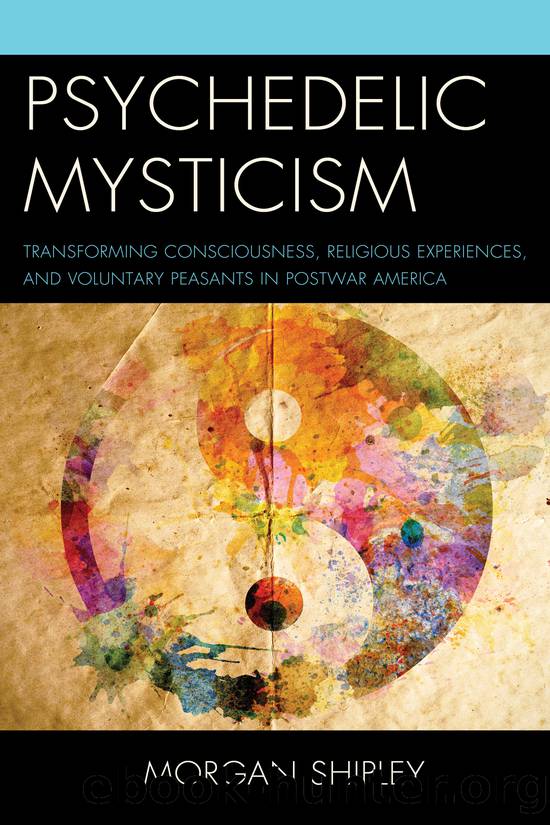Psychedelic Mysticism by Shipley Morgan;

Author:Shipley, Morgan;
Language: eng
Format: epub
Publisher: Lexington Books/Fortress Academic
Chapter 4
âTrust your Divinity, Trust your Brain, Trust your Companionsâ
Psychedelic Manuals, Entheogens, and the Flowering of a Perennial Religion
All things began in order, so shall they end, and so shall they begin again.
âSir Thomas Browne, âThe Garden of Cyrusâ
In the introductory foreword to the first-ever (1927) English translation of the Bardo Thödol (what editor W.Y. Evans-Wentz translates to mean The Tibetan Book of the Dead), LÄma Anagarika Govindaâa Western convert to Buddhism who helped expose the West to Tibetan Buddhism and meditative practicesâstresses the symbolic and metaphoric inner meaning of the text, how the text âis far more . . . [than] religious speculation about death and a hypothetical after-death state . . . it is a key to the innermost recesses of the human mind, and a guide for initiates, and for those who are seeking the spiritual path of liberation.â1 Even the popularized name, The Tibetan Book of the Dead, reflects the ineffable states described within the text itselfâits misnomer, being a âbook of the dead,â obscures how the Bardo Thödol operates for the living, for the intermediate planes between life, death, and rebirth.2 In this way, by interrogating the bardosâbetween states of consciousnessâthe Bardo Thödol guides access to âthe unrestricted treasury of subconscious memory, wherein are stored the records not only of our past lives but the records of the past of our race, the past of humanity, and of all pre-human forms of life,â as Govinda stresses.3 Based on his belief in a recurring cycle that connects the âpast,â the âpre-human,â and universal âconsciousnessâ within the immediate present, Govinda identifies a foundational perennialism at the heart of Buddhismâs understanding of life and death.
The literal translation of the Bardo Thödol bears this out. More than a name which parallels another ancient funerary text, the Egyptian Book of the Dead, the Bardo Thödolâfrom the Tibetan bardo (the âbetween-stateâ) and thödol (liberation)âcommonly translates as Liberation Through Hearing During the Intermediate State or, more simply, Liberation Through Hearing.4 Yet even this etymology fails to account for the full nuances of the Tibetan title Bardo thos grol chen mo. According to Robert Thurman, âin the actual Tibetan title, Bardo thos grol, bardo simply means the âbetween-stateâ . . . the words thos grol mean that this bookâs teaching âliberatesâ just by being âlearnedâ or âunderstood,â giving the person facing the between an understanding so naturally clear and deep that it does not require prolonged reflection or contemplation.â5 Because of this, Thurman prefers âthe most common Tibetan title of the work . . . The Great Book of Natural Liberation Through Understanding in the Between.â6 Liberation, hearing, understanding, âbetween-stateââwhen read this way, the text operates from within states of consciousness unburdened, that is, âlimitlessâ experiences characterized primarily, much like the psychedelic experience according to Timothy Leary, Richard Alpert, and Ralph Metzner, by âthe transcendence of verbal concepts, of space-time dimensions, and of the ego and identity.â7
Yet as the very structure of the Bardo Thödol suggests, such liberation neither comes spontaneously nor immediately, but emerges by following the instructions outlined in the text.
Download
This site does not store any files on its server. We only index and link to content provided by other sites. Please contact the content providers to delete copyright contents if any and email us, we'll remove relevant links or contents immediately.
Getting It, Then Getting Along by L. Reynolds Andiric(610)
Global Justice, Christology and Christian Ethics by Lisa Sowle Cahill(387)
Religion and Politics Beyond the Culture Wars : New Directions in a Divided America by Darren Dochuk(387)
Positive Psychology in Christian Perspective: Foundations, Concepts, and Applications by Charles Hackney(324)
Forgiveness and Christian Ethics by Unknown(308)
Douglas Hamp The First Six Days by Unknown(210)
Christian Martyrdom and Christian Violence by Matthew D. Lundberg;(201)
The Oxford Handbook of Greek and Roman Mythography by R. Scott Smith;Stephen M. Trzaskoma;(194)
Beyond Heaven and Earth by Gabriel Levy(188)
God and Eros by Patterson Colin;Sweeney Conor;(187)
The Bloomsbury Reader in Christian-Muslim Relations, 600-1500 by David Thomas;(186)
Insurgency, Counter-insurgency and Policing in Centre-West Mexico, 1926-1929 by Mark Lawrence(185)
The Horrors and Absurdities of Religion by Arthur Schopenhauer(180)
Cult Trip by Anke Richter(172)
Witches: the history of a persecution by Nigel Cawthorne(171)
Autobiography, Volume 2: 1937-1960, Exile's Odyssey by Mircea Eliade(171)
The Myth of Disenchantment by Jason A. Josephson-Storm(156)
An Introduction to Kierkegaard by Peter Vardy(154)
The Believer by Sarah Krasnostein(150)
